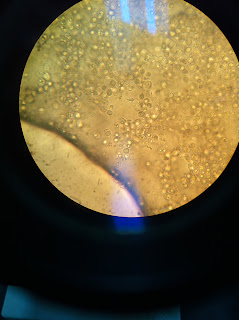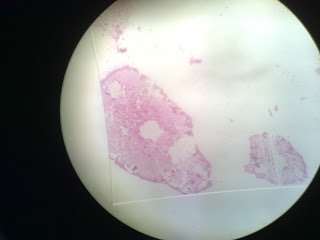Name : See Yen Shan
Matrix number : 111415
1. Introduction
1.1 Setting
up and using the microscope
Microorganism need to
be magnified in order to be seen. The light microscope is the instrument that
most frequently used in viewing the microorganisms. Besides that, we have to
observe some bacteria.
1.2 Examination
of the cells
Because of the
minuteness of the bacteria, they are not generally studied with low-power or
high-power dry objectives. Instead they are stained and observed with the oil
immersion objective.The wet mount methods enable us to study the sizes and the
shapes of living microorganisms instead of drying and staining microorganisms
as these two method distort them. The wet mount method also enables us to
determine the motility of the cells. This method is quick and easy, as well as
does not require special equipment.
2. Objective
2.1 Learn
to use the simple bright-field microscope correctly.
2.2.1 To
provide an experience in the use of microscope.
2.2.2 To illustrate the
diversity of cells and microorganisms.
3. Result
3.1 Typical
Bacillus
 |
| with 40x magnification |
 |
| with 100x magnification |
 |
| with 400x magnification |
3.2.1 Lactobacillus fermentum
 |
| with 1000x magnification |
3.2.2 Saccaromyces cerevisiae
_%E5%89%AF%E6%9C%AC.jpg) |
| with 1000x magnification |
4. Discussion
4.1 From
the first experiment, the shape of the Typical
bacillus are in the irregular shape. It is red in colour and they are
non-motile. The surface of the microorganisms is smooth. Whereas the texture is
dry.
4.2 From
the wet mount experiment, the Lactobacillus
fermentum are in a rod shape, we can also observe that they are motile when
they are alive. The colour of Lactobacillus
fermentum are light grey as well as shinny and smooth in appearance. The
texture is in moist form.
4.2.1 Saccharomyces
cerevisiae are unicellular fungi that are typically spherical or oval,
and ellipsoid to elongate in shape. Multilateral budding is typical. The hyphae are absent. But they are not
motile. Saccharomyces
cerevisiae are non
filamentous. They are in yellowish and appear in moist form. The surface of it is dull and rough.
5. Conclusions
5.1 In
conclusion, we can observe the Typical bacillus
under 40x magnification but as we switch
to the bigger the magnification, we can get a clearer result.
5.2 From
the experiment of the wet mount, we can conclude that the power of 1000x
magnification with the immersion oil must be used in order to observe the target microorganisms
clearly. The motility of both
Lactobacillus fermentum and Saccharomyces
cerevisiae are being observed under that certain power too.
References
P.F.Cannon
and P.M.Kirk (2007) Saccharomycetaceae G.Winter1881 in Fungal Families of the World: 320-321
Gerard
J.Tortora, Berdell R.Funke, Christine L.Case (1992) Fungi, Algae, Protozoans, and
Multicellular Parasites in Microbiology:
298-299

.jpg)
.jpg)

_%E5%89%AF%E6%9C%AC.jpg)










